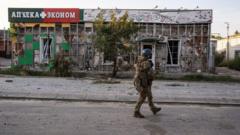A significant ceasefire deal is on the horizon between Israel and Hamas, potentially bringing an end to the ongoing conflict in Gaza. Negotiations have centered on hostage exchanges and rebuilding efforts, but questions remain about the long-term implications and feasibility of the agreement.
Potential Ceasefire Deal Emerges Amid Gaza Conflict

Potential Ceasefire Deal Emerges Amid Gaza Conflict
Israel and Hamas are reportedly nearing an agreement for a ceasefire that could halt the 15-month-old war and facilitate the exchange of hostages and prisoners.
In a significant development, Israel and Hamas are reportedly close to finalizing a ceasefire deal aimed at halting the intense fighting in Gaza, which has seen almost the entire population displaced amidst violence and turmoil. This proposed agreement may also lead to the exchange of Israeli hostages for Palestinian prisoners, marking the most significant breakthrough after 15 turbulent months of conflict that began with a surprise attack by Hamas on Israel in October 2023.
The proposed ceasefire is anticipated to unfold in three distinct stages, though specifics are still being negotiated and could change before a formal agreement is reached. The first stage would involve the exchange of 34 hostages, primarily civilians, for a significant number of Palestinian prisoners, with three hostages being released immediately and the remaining exchanges occurring over a period of six weeks. Concurrently, Israeli forces are expected to begin withdrawing from populated areas of Gaza.
The second stage is expected to focus on the release of remaining hostages, including soldiers and reservists, in exchange for additional Palestinian prisoners. Among the roughly 1,000 Palestinian prisoners slated for potential release, a notable number have been serving lengthy sentences for serious crimes. During this timeframe, displaced Gazans currently in the southern regions would be allowed to return to their homes in the north.
The final phase emphasizes the reconstruction of Gaza, a daunting task projected to take several years to complete. Throughout this process, Israeli forces may remain in a designated buffer zone, ensuring some level of security amidst the fragile peace.
However, the negotiations leading to this potential ceasefire have been fraught with challenges, given the deep-seated mistrust between Israel and Hamas. Notably, Hamas has insisted on a complete cessation of hostilities as a precursor to releasing hostages, a condition that Israel has deemed unacceptable. As such, while the ceasefire offers a temporary respite, uncertainty looms over whether it signals a permanent resolution to the conflict.
The situation remains precarious as both sides continue to grapple with complex demands and unresolved questions regarding the well-being of hostages and the logistics of a potential withdrawal by Israeli forces from designated areas. Previous ceasefires have often unraveled due to minor incidents, and the evolving nature of this ceasefire adds further uncertainty to what lies ahead.
The conflict erupted on October 7, 2023, when Hamas orchestrated an unprecedented attack on Israel, resulting in significant casualties, the capture of hostages, and subsequent military retaliation from Israel. The ensuing military campaign has severely impacted the civilian population in Gaza, leading to widespread devastation and a humanitarian crisis, with over 46,600 fatalities reported, according to health authorities in Gaza.






















